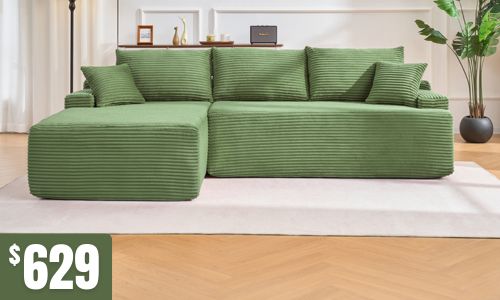Posts tagged with 'space constraints'
 In an era where adaptability and efficiency are highly valued, the concept of modular furniture has gained remarkable prominence in interior design. Beyond the aesthetic appeal and creative expression that furnishings bring to a space, the functionality they offer plays a pivotal role in shaping our living environments. Amongst these functional marvels, modular furniture stands out as a testament to human ingenuity, offering an unparalleled level of versatility that has the power to transform spaces both large and small.
In an era where adaptability and efficiency are highly valued, the concept of modular furniture has gained remarkable prominence in interior design. Beyond the aesthetic appeal and creative expression that furnishings bring to a space, the functionality they offer plays a pivotal role in shaping our living environments. Amongst these functional marvels, modular furniture stands out as a testament to human ingenuity, offering an unparalleled level of versatility that has the power to transform spaces both large and small.
The Evolution of Design: From Static to Dynamic
Traditional furniture, with its fixed forms and functions, often limited the possibilities of interior design. In contrast, modular furniture emerges as a dynamic solution that adapts to the changing needs of modern living. Its inception can be traced back to the mid-20th century when designers began exploring the concept of modularity to provide users with the flexibility to arrange and rearrange their furniture according to their spatial requirements.
The Art of Versatility
The core principle behind modular furniture is its adaptability. Pieces are designed to be easily reconfigured, allowing users to customise their arrangement based on factors such as space constraints, functional needs, and aesthetic preferences. From modular sofas that transform into beds, to bookshelves that double as room dividers, the possibilities are virtually endless. This adaptability not only maximises the utility of each piece but also fosters creativity in design, as users are encouraged to experiment with different layouts.
Small Spaces, Big Impact
One of the most compelling applications of modular furniture is in compact living spaces. As urbanisation drives the creation of smaller living units, the demand for furniture that can make the most of limited square footage grows. Modular pieces cater perfectly to this need, offering the ability to switch between various functions without compromising on style or comfort. For instance, a modular dining table with folding panels can expand to accommodate guests, then shrink back down to save space when not in use.
Sustainability and Longevity
Modular furniture also aligns with the principles of sustainability and longevity. The modular approach promotes a reduction in waste, as users can add or replace components as needed instead of discarding entire pieces of furniture. This not only minimises environmental impact but also encourages a shift away from the disposable culture that has become all too common. Moreover, the durability of modular designs, often attributed to their high-quality materials and craftsmanship, ensures that these pieces can withstand the test of time.
The Blend of Form and Function
A key challenge in design lies in finding the balance between form and function. Modular furniture gracefully addresses this challenge by seamlessly integrating aesthetics with practicality. The modular concept invites designers to think outside the conventional box, resulting in furniture that not only performs well but also sparks visual interest. From sleek, minimalist lines to bold, artistic shapes, modular pieces can cater to a wide range of design sensibilities.
The Future of Interior Design
As we look ahead, the trajectory of interior design appears intertwined with the continued evolution of modular furniture. With advancements in technology, we can anticipate even more innovative designs that incorporate smart features and customisable elements. The ability to connect and control modular pieces through digital interfaces may soon become a reality, further enhancing the adaptability and convenience of these furnishings.
The versatility of modular furniture marks a paradigm shift in interior design. Its transformative power not only shapes spaces to suit our needs but also fosters a sense of engagement and creativity. In a world where change is constant and spatial constraints are a reality, modular furniture emerges as a beacon of adaptability, sustainability, and design excellence. As designers and homeowners alike embrace this versatile trend, we can expect living spaces to become more functional, more efficient, and ultimately, more captivating than ever before.
Adapt as you go with modular furniture. Check out our modular sofas to start off!

Selecting the right commercial furniture for your space is essential to create a functional, aesthetically pleasing, and comfortable environment. Whether you're furnishing an office, restaurant, hotel, or retail store, considering the following factors will help you make informed decisions that meet your specific needs. In this informative article, we will explore the key factors to consider when choosing commercial furniture for your space.
Functionality and Purpose: First and foremost, assess the functionality and purpose of the furniture. Consider how the furniture will be used and what activities it needs to support. For example, office furniture should prioritise ergonomics and productivity, while restaurant furniture should be durable and easy to clean. Understanding the specific requirements of your space will guide you in selecting furniture that meets your functional needs.
Space Constraints and Layout: Take into account the available space and layout of your commercial area. Measure the dimensions of the space to ensure that the furniture you choose fits appropriately. Consider factors such as walkways, clearances, and the arrangement of other elements in the space. Optimise your furniture selection to maximise the use of available space and create a comfortable flow for customers or employees.
Aesthetics and Brand Identity: Commercial furniture plays a significant role in shaping the overall aesthetics and brand identity of your space. Consider the desired ambiance and atmosphere you want to create. Choose furniture styles, colours, and materials that align with your brand image and complement the overall design theme. Whether it's modern, classic, rustic, or contemporary, the furniture should enhance the visual appeal and convey your desired message to customers or clients.
Durability and Maintenance: Commercial spaces experience heavy use, so durability is crucial when selecting furniture. Look for high-quality materials known for their sturdiness and resistance to wear and tear. Consider factors such as frame construction, upholstery quality, and finishes. Additionally, assess the maintenance requirements of the furniture. Opt for materials that are easy to clean and maintain, especially in high-traffic areas or environments prone to spills or stains.
Comfort and Ergonomics: Comfort is key, especially when it comes to furniture that will be used for long periods. Prioritise ergonomics by selecting chairs, sofas, or seating options that offer proper support and encourage good posture. Consider adjustable features, such as seat height or lumbar support, to accommodate various body types and preferences. Comfortable furniture contributes to employee satisfaction and customer experience, enhancing the overall functionality of your space.
Budget and Value for Money: Establish a budget for your commercial furniture project and seek options that offer the best value for money. Compare prices, quality, and warranties from different suppliers. Consider the long-term value of the furniture in terms of durability, maintenance costs, and potential for reconfiguration or expansion. Striking a balance between quality and affordability will ensure you make a wise investment that meets your budget constraints.
Ensuring the quality of commercial furniture is essential for its durability and performance. Here are a few steps you can take to assess the quality:
Research and reputation: Look for reputable manufacturers or suppliers with a track record of producing high-quality furniture. Read customer reviews and testimonials to gauge their reputation and the experiences of other buyers.
Material selection: Pay attention to the materials used in the furniture. Choose the right material for your space. It can be solid wood or engineered wood which is suitable for commercial usage.
Construction and craftsmanship: Examine the construction and craftsmanship of the furniture. Check for sturdy joints, reinforced frames, and attention to detail. Well-built furniture is less likely to wear down quickly.
In conclusion, choosing the right commercial furniture for your space requires careful consideration of various factors. Assessing functionality, considering space constraints, aligning with brand aesthetics, prioritising durability and maintenance, ensuring comfort and ergonomics, and managing your budget are all key elements in making an informed decision. By taking these factors into account and assessing the quality of the furniture through research, reputation, material selection, and construction, you can create a functional, visually appealing, and long-lasting environment for your commercial space. Remember, investing in the right commercial furniture is a crucial step towards creating a space that meets your specific needs and leaves a positive impression on customers and employees alike.
Check our commercial grade furniture!




.jpeg)

 (3).jpeg)
